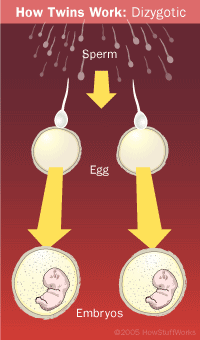Baby Making 101
The key to human reproduction is fertilization. The optimum time for fertilization to take place is during ovulation, which occurs about mid-way through a woman's menstrual cycle. If the one egg released during ovulation is fertilized by a male's sperm, here's what happens next:
- Sometime around day one-and-a-half, conception occurs; the fertillized egg, now called a zygote divides one time, resulting in two cells.
- By approximately four days after fertilization, the zygote has about 100 cells and is called a blastocyst.
- By the sixth day after fertilization, the blastocyst implants itself in the uterine wall where it will continue to develop for approximately nine months.
Initially after implantation, the developing baby is called an embryo. Around week nine of development, it is called a fetus. The developing baby is suspended and protected by the fluid-filled amniotic sac and it receives nourishment and oxygen and eliminates waste via the umbilical chord and placenta.
Advertisement
Now that you know how a singleton (single baby) is created, let's look at how twins form.
There are two basic types of twins: monozygotic (also known as "identical") and dizygotic (also known as "fraternal").

There's no doubt that identical twins stand out more and are more easily recognized. However, they are not the most prevalent type of twins. In fact, you might be surprised to find that two thirds of all twins are dizygotic. Dizygotic twins occur when two sperm fertilize two distinct eggs. In this instance, rather than releasing one egg during ovulation, the mother has released two. (For higher multiple births, more eggs are released - for example, in trizygotic triplets, three eggs are fertilized by three sperm.)
Dizygotic (DZ), or fraternal twins, can be one of three combinations:
- Two males (represents about one-fourth of all DZ twin sets)
- Two females (represents about one-fourth of all DZ twin sets)
- One male and one female (represents one-half of all DZ twin sets)
The fertilization of two eggs by two sperm results in two separate embryos — each with its own chorion (outer membrane of the amniotic sac), amnion (inner membrane of the amniotic sac) and placenta. In some instances, if the embryos implant very nearby each other along the uterine wall, the placentas can become fused.
Because they are formed from two distinct eggs and two distinct sperm, DZ twins are genetically no more similar than regular siblings are, sharing 50 percent of their DNA.
